|
 Russula roseostipitata Russula roseostipitata
BiostatusPresent in region - Indigenous. Endemic
Images (click to enlarge)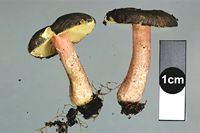
Owner: J.A. Cooper | 
Owner: J.A. Cooper | 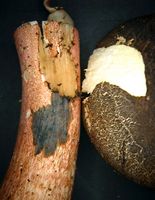
Caption: top: FeSO4, bottom: guaiac.
Owner: J.A. Cooper | 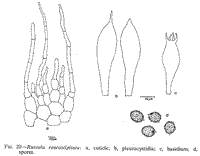 | 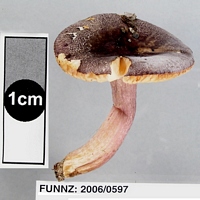
Caption: FUNNZ: 2006/0597, See public note for more information
Owner: FUNNZ | 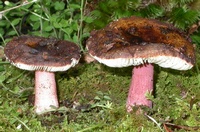
Owner: P. Leonard | 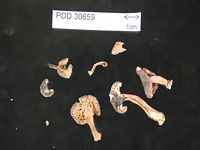
Caption: Dried type specimen
Owner: Herb PDD |
Article: McNabb, R.F.R. (1973). Russulaceae of New Zealand. 2. Russula Pers. ex S.F. Gray. New Zealand Journal of Botany 11(4): 673-730 (http://www.rsnz.org/publish/abstracts.php).
Description: pileus: 2-6 cm diam., convex when young, centrally
depressed at maturity, slightly viscid under wet conditions, otherwise dry,
finely sub-pruinose to pruinose under lens, velar remnants absent, deep greyish
magenta, often dark grey to black and finely creviced giving a sooty appearance
towards margins, sometimes with faint greenish yellow patches; margins entire
non-pectinate. Cuticle composed of erect, thin-walled or slightly thick-walled,
smooth or finely roughened, septate, hair like hyphae to 150 µm long, 3.5-7
µm diam., without coloured contents in KOH, terminal cells unspecialised, tapering
apically, originating from a layer of sphaerocysts 5-10 cells deep; pilocystidia
absent. lamellae: adnate,
crowded, thin, simple or occasionally forked near stipe, to 5 mm deep, cream
to pallid ochraceous, not discoloured at maturity but edges occasionally tinted
with colours of stipe, lamellulae rare or absent. stipe: 2-4.5
cm long, ± equal or expanded basally, 0.5-1 cm diam., dry, solid or slightly
chambered at maturity, finely furfuraceous under lens, pink, pinkish red, pinkish
magenta, or dull greyish red, flesh often showing through; flesh white, unchanging
on exposure to air. Cuticle composed of interwoven, repent, thin-walled, septate
hyphae 3.5-6 µm diam., terminal cells projecting and aggregated into
clumps; caulocystidia absent. spores: spore
print not obtained; spores broadly elliptical, obliquely apiculate, apiculus
to 1.5-(2) µm long, 10-13 X 9-11.2 µm, ornamentation of dense, amyloid or partially
inamyloid, truncated spines to 1.5 µm high, isolated or in small confluent groups,
rarely adjacent spines joined basally by fine amyloid ridges, plage distinct.
hymenium: basidia hyaline, clavate, 35-47 XI 1-15
µm, 4-spored, sterigmata to 8 µm long; pleurocystidia scattered, numerous, broadly
fusiform, hyaline, thin-walled, contents sparse, refractive in KOH, projecting
to 15 µm beyond basidia, 49-73 X 10-16.5 µm, cheilocystidia numerous,
similar to pleurocystidia but shorter. hymenophoral trama:
heteromerous, intermixed, oleiferous hyphae rare. context of pileus: white, unchanging; structure heteromerous,
clamp connections absent. taste: lamellae and context mild. chemical characters: formalin on context —n.r.; phenol on
context—slowly deep vinaceous; FeSO4 on context— rapidly greyish green; guaiacol
on stipe base—n.r.; KOH on pileus— magenta colour disappearing leaving area
orange-red; on context—n.r.; NH4OH on pileus and context—n.r.
Habitat: Solitary or gregarious under Nothofagus.
Notes: The species is characterised by the cream to
pallid ochraceous lamellae, the densely ornamented spores, and the greyish green
colour reaction of the context with FeSO4 Russula roseostipitata belongs
in section Rigidae, although it is difficult to place it in any of the
subsections recognised by Singer (1962). The distinctive cuticular structure
indicates that it belongs near subsection Virescentinae.
|